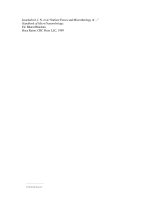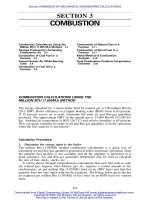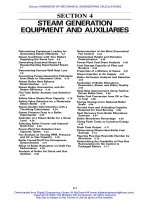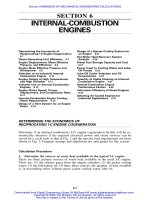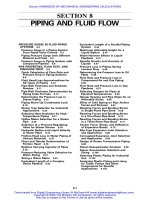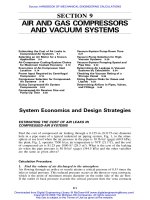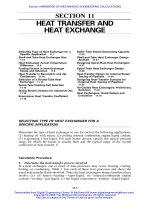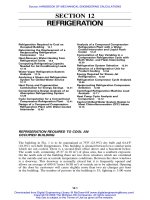Tài liệu Handbook of Corrosion Engineering P1 pptx
Bạn đang xem bản rút gọn của tài liệu. Xem và tải ngay bản đầy đủ của tài liệu tại đây (386.88 KB, 30 trang )
Handbook of
Corrosion
Engineering
Pierre R. Roberge
McGraw-Hill
New York San Francisco Washington, D.C. Auckland Bogotá
Caracas Lisbon London Madrid Mexico City Milan
Montreal New Delhi San Juan Singapore
Sydney Tokyo Toronto
0765162_FM_Roberge 9/1/99 2:36 Page iii
Library of Congress Cataloging-in-Publication Data
Roberge, Pierre R.
Handbook of Corrosion Engineering / Pierre R. Roberge.
p. cm.
Includes bibliographical references.
ISBN 0-07-076516-2 (alk. paper)
1. Corrosion and anti-corrosives. I. Title.
TA418.74.R63 1999
620.1'1223—dc21 99-35898
CIP
Copyright © 2000 by The McGraw-Hill Companies, Inc. All rights
reserved. Printed in the United States of America. Except as permit-
ted under the United States Copyright Act of 1976, no part of this
publication may be reproduced or distributed in any form or by any
means, or stored in a data base or retrieval system, without the prior
written permission of the publisher.
1 2 3 4 5 6 7 8 9 AGM/AGM 9 0 4 3 2 1 0 9
ISBN 0-07-076516-2
The sponsoring editor of this book was Robert Esposito. The editing
supervisor was David E. Fogarty, and the production supervisor was
Sherri Souffrance. This book was set in New Century Schoolbook by
Joanne Morbit and Paul Scozzari of McGraw-Hill’s Professional Book
Group in Hightstown, N.J.
Printed and bound by Quebecor/Martinsburg.
This book was printed on recycled, acid-free paper contain-
ing a minimum of 50% recycled, de-inked fiber.
McGraw-Hill books are available at special quantity discounts to use
as premiums and sales promotions, or for use in corporate training
programs. For more information, please write to the Director of Special
Sales, McGraw-Hill, 11 West 19th Street, New York, NY 10011. Or
contact your local bookstore.
McGraw-Hill
Information contained in this work has been obtained by The McGraw-Hill
Companies, Inc. (“McGraw-Hill) from sources believed to be reliable. However,
neither McGraw-Hill nor its authors guarantee the accuracy or completeness
of any information published herein and neither McGraw-Hill nor its authors
shall be responsible for any errors, omissions, or damages arising out of use of
this information. This work is published with the understanding that
McGraw-Hill and its authors are supplying information but are not attempt-
ing to render engineering or other professional services. If such services are
required, the assistance of an appropriate professional should be sought.
0765162_FM_Roberge 9/1/99 2:36 Page iv
Contents
Preface ix
Acknowledgments xi
Introduction 1
1.1 The Cost of Corrosion 1
1.2 Examples of Catastrophic Corrosion Damage 3
1.3 The Influence of People 5
References 12
Chapter 1. Aqueous Corrosion 13
1.1 Introduction 13
1.2 Applications of Potential-pH Diagrams 16
1.3 Kinetic Principles 32
References 54
Chapter 2. Environments 55
2.1 Atmospheric Corrosion 58
2.2 Natural Waters 85
2.3 Seawater 129
2.4 Corrosion in Soils 142
2.5 Reinforced Concrete 154
2.6 Microbes and Biofouling 187
References 216
Chapter 3. High-Temperature Corrosion 221
3.1 Thermodynamic Principles 222
3.2 Kinetic Principles 229
3.3 Practical High-Temperature Corrosion Problems 237
References 265
0765162_FM_Roberge 9/1/99 2:36 Page v
Chapter 4. Modeling, Life Prediction and Computer Applications 267
4.1 Introduction 267
4.2 Modeling and Life Prediction 268
4.3 Applications of Artificial Intelligence 303
4.4 Computer-Based Training or Learning 322
4.5 Internet and the Web 324
References
Chapter 5. Corrosion Failures 331
5.1 Introduction 332
5.2 Mechanisms, Forms, and Modes of Corrosion Failures 332
5.3 Guidelines for Investigating Corrosion Failures 359
5.4 Prevention of Corrosion Damage 360
5.5 Case Histories in Corrosion Failure Analysis 368
References 369
Chapter 6. Corrosion Maintenance Through Inspection And Monitoring 371
6.1 Introduction 372
6.2 Inspection 374
6.3 The Maintenance Revolution
6.4 Monitoring and Managing Corrosion Damage 406
6.5 Smart Sensing of Corrosion with Fiber Optics 448
6.6 Non-destructive Evaluation (NDE) 461
References 481
Chapter 7. Acceleration and Amplification of Corrosion Damage 485
7.1 Introduction 486
7.2 Corrosion Testing 488
7.3 Surface Characterization 562
References 574
Chapter 8. Materials Selection 577
8.1 Introduction 578
8.2 Aluminum Alloys 584
8.3 Cast Irons 612
8.4 Copper Alloys 622
8.5 High-Performance Alloys 664
8.6 Refractory Metals 692
8.7 Stainless Steels 710
8.8 Steels 736
8.9 Titanium 748
8.10 Zirconium 769
References 777
Chapter 9. Protective Coatings 781
9.1 Introduction 781
9.2 Coatings and Coating Processes 782
Contents
0765162_FM_Roberge 9/1/99 2:36 Page vi
326
383
9.3 Supplementary Protection Systems 829
9.4 Surface Preparation 831
References 831
Chapter 10. Corrosion Inhibitors 833
10.1 Introduction 833
10.2 Classification of Inhibitors 834
10.3 Corrosion Inhibition Mechanism 838
10.4 Selection of an Inhibitor System 860
References 861
Chapter 11. Cathodic Protection 863
11.1 Introduction 863
11.2 Sacrificial Anode CP Systems 871
11.3 Impressed Current Systems 878
11.4 Current Distribution and Interference Issues 886
11.5 Monitoring the Performance of CP Systems for Buried Pipelines 904
References 919
Chapter 12. Anodic Protection 921
12.1 Introduction 921
12.2 Passivity of Metals 923
12.3 Equipment Required for Anodic Protection 927
12.4 Design Concerns 930
12.5 Applications 932
12.6 Practical Example: Anodic Protection in the Pulp and Paper Industry 933
References 938
Appendix A. SI Units 939
Appendix B. Glossary 947
Appendix C. Corrosion Economics 1001
C.1 Introduction 1001
C.2 Cash Flows and Capital Budgeting Techniques 1002
C.3 Generalized Equation for Straight Line Depreciation 1004
C.4 Examples 1006
C.5 Summary 1009
References 1009
Appendix D. Electrochemistry Basics 1011
D.1 Principles of Electrochemistry 1011
D.2 Chemical Thermodynamics 1029
D.3 Kinetic Principles 1047
0765162_FM_Roberge 9/1/99 2:36 Page vii
Appendix E. Chemical Compositions of Engineering Alloys 1061
Appendix F. Thermodynamic Data and E-pH Diagrams 1101
Appendix G. Densities and Melting Points of Metals 1125
Index 1129
Contents
0765162_FM_Roberge 9/1/99 2:36 Page viii
Preface
The design and production of the Handbook of Corrosion Engineering
are drastically different than other handbooks dealing with the same
subject. While other corrosion handbooks have been generally the
results of collective efforts of many authors, the Handbook of
Corrosion Engineering is the result of an extensive survey of state-of-
the-art information on corrosion engineering by a principal author.
Although only one author appears on the cover, this Handbook is
indeed the result of cumulative efforts of many generations of scien-
tists and engineers in understanding and preventing the effects of cor-
rosion, one of the most constant foes of human endeavors. The design
and construction of this Handbook were made for the new millennium
with the most modern information-processing techniques presently
available. Many references are made to sources of information readily
accessible on the World Wide Web and to software systems that can
simplify the most difficult situation. It also provides elements of infor-
mation management and tools for managing corrosion problems that
are particularly valuable to practicing engineers. Many examples, for
example, describe how various industries and agencies have addressed
corrosion problems. The systems selected as supportive examples have
been chosen from a wide range of applications across various industries,
from aerospace structures to energy carriers and producers.
This Handbook is aimed at the practicing engineer, as a comprehen-
sive guide and reference source for solving material selection problems
and resolving design issues where corrosion is possibly a factor.
During the past decades, progress in the development of materials
capable of resisting corrosion and high temperatures has been signifi-
cant. There have been substantial developments in newer stainless
steels, high-strength low-alloy steels, superalloys, and in protective
coatings. This Handbook should prove to be a key information source
concerning numerous facets of corrosion damage, from detection and
monitoring to prevention and control.
The Handbook is divided into three main sections and is followed by
supporting material in seven appendixes. Each section and its chapters
are relatively independent and can be consulted without having to go
through previous chapters. The first main section (Introduction and
0765162_FM_Roberge 9/1/99 2:36 Page ix
Chapters 1 to 3) contains fundamental principles governing aqueous
corrosion and high-temperature corrosion and covers the main environ-
ments causing corrosion such as atmospheric, natural waters, seawater,
soils, concrete, as well as microbial and biofouling environments.
The second section (Chapters 4 to 7) addresses techniques for the pre-
diction and assessment of corrosion damage such as modeling, life pre-
diction, computer applications, inspection and monitoring and testing
through acceleration and amplification of corrosion damage. The second
section also contains a detailed description of the various types of corro-
sion failures with examples and ways to prevent them. The third section
(Chapters 8 to 12) covers general considerations of corrosion prevention
and control with a focus on materials selection. This chapter is particu-
larly valuable for its detailed descriptions of the performance and main-
tenance considerations for the main families of engineering alloys based
on aluminum, copper, nickel, chrome, refractory metals, titanium and
zirconium, as well as cast irons, stainless steels and other steels. This
section also provides elements for understanding protective coatings,
corrosion inhibitors, cathodic protection and anodic protection.
The first appendix contains a table of appropriate SI units making
references to most other types of units. This table will hopefully com-
pensate for the systematic usage of SI units made in the book. Another
appendix is an extensive glossary of terms often used in the context of
corrosion engineering. A third appendix summarizes corrosion econom-
ics with examples detailing calculations based on straight value depre-
ciation. The fourth appendix provides a detailed introduction to basic
electrochemical principles. Many examples of E-pH (Pourbaix) dia-
grams are provided in a subsequent appendix. The designations and
compositions of engineering alloys is the subject of a fifth appendix.
Pierre R. Roberge
Preface
0765162_FM_Roberge 9/1/99 2:36 Page x
Acknowledgments
The Handbook of Corrosion Engineering was designed entirely in collab-
oration with Martin Tullmin. In fact, Martin is the sole author of many
sections of the book (corrosion in concrete, soil corrosion and cathodic
protection) as well as an important contributor to many others. My
acknowledgments also go to Robert Klassen who contributed to the
atmospheric corrosion section as well as for his study of the fiber optic
sensors for corrosion monitoring.
As I mentioned in the Preface, this book tries to summarize the pre-
sent state of our knowledge of the corrosion phenomena and their
impact on our societies. Many of the opinions expressed in the
Handbook have come either from my work with collaborators or, more
often, from my study of the work of other corrosion engineers and sci-
entists. Of the first kind I am particularly indebted to Ken Trethewey
with whom I have had many enlightening discussions that sometimes
resulted in published articles. I also have to thank the congenial
experts I interacted with in corrosion standard writing committees
(ISO TC 156 and ASTM G01) for their expert advice and the rigor that
is required in the development of new procedures and test methods.
Of the second kind I have to recognize the science and engineering
pillars responsible for the present state of our knowledge in corrosion.
The names of some of these giants have been mentioned throughout
the book with a particular recognition made in the Introduction in
Table I.4. In this respect, my personal gratitude goes to Professor Roger
Staehle for his pragmatic vision of the quantification of corrosion dam-
age. I have been greatly inspired by the work of this great man.
I would also like to take this occasion to express my love to those
close to me, and particularly to Diane whose endurance of my working
habits is phenomenal.
0765162_FM_Roberge 9/1/99 2:36 Page xi
1
I.1 The Cost of Corrosion 1
I.2 Examples of Catastrophic Corrosion Damage 3
I.2.1 Sewer explosion, Mexico 3
I.2.2 Loss of USAF F16 fighter aircraft 3
I.2.3 The Aloha aircraft incident 3
I.2.4 The MV KIRKI 4
I.2.5 Corrosion of the infrastructure 4
I.3 The Influence of People 5
Introduction
Corrosion is the destructive attack of a material by reaction with its
environment. The serious consequences of the corrosion process have
become a problem of worldwide significance. In addition to our every-
day encounters with this form of degradation, corrosion causes plant
shutdowns, waste of valuable resources, loss or contamination of prod-
uct, reduction in efficiency, costly maintenance, and expensive over-
design; it also jeopardizes safety and inhibits technological progress.
The multidisciplinary aspect of corrosion problems combined with the
distributed responsibilities associated with such problems only
increase the complexity of the subject. Corrosion control is achieved by
recognizing and understanding corrosion mechanisms, by using corro-
sion-resistant materials and designs, and by using protective systems,
devices, and treatments. Major corporations, industries, and govern-
ment agencies have established groups and committees to look after
corrosion-related issues, but in many cases the responsibilities are
spread between the manufacturers or producers of systems and their
users. Such a situation can easily breed negligence and be quite cost-
ly in terms of dollars and human lives.
I.1 The Cost of Corrosion
Although the costs attributed to corrosion damages of all kinds have
been estimated to be of the order of 3 to 5 percent of industrialized
countries’ gross national product (GNP), the responsibilities associat-
ed with these problems are sometimes quite diffuse. Since the first sig-
nificant report by Uhlig
1
in 1949 that the cost of corrosion to nations
is indeed great, the conclusion of all subsequent studies has been that
corrosion represents a constant charge to a nation’s GNP.
2
One conclu-
sion of the 1971 UK government-sponsored report chaired by Hoar
3
was that a good fraction of corrosion failures were avoidable and that
improved education was a good way of tackling corrosion avoidance.
0765162_Intro_Roberge 9/1/99 2:38 Page 1
Corrosion of metals cost the U.S. economy almost $300 billion per
year at 1995 prices.
4
Broader application of corrosion-resistant mate-
rials and the application of the best corrosion-related technical prac-
tices could reduce approximately one-third of these costs. These
estimates result from a recent update by Battelle scientists of an ear-
lier study reported in 1978.
5
The initial work, based upon an elaborate
model of more than 130 economic sectors, had revealed that metallic
corrosion cost the United States $82 billion in 1975, or 4.9 percent of
its GNP. It was also found that 60 percent of that cost was unavoid-
able. The remaining $33 billion (40 percent) was said to be “avoidable”
and incurred by failure to use the best practices then known.
In the original Battelle study, almost 40 percent of 1975 metallic cor-
rosion costs were attributed to the production, use, and maintenance
of motor vehicles. No other sector accounted for as much as 4 percent
of the total, and most sectors contributed less than 1 percent. The 1995
Battelle study indicated that the motor vehicles sector probably had
made the greatest anticorrosion effort of any single industry. Advances
have been made in the use of stainless steels, coated metals, and more
protective finishes. Moreover, several substitutions of materials made
primarily for reasons of weight reduction have also reduced corrosion.
Also, the panel estimated that 15 percent of previously unavoidable
corrosion costs can be reclassified as avoidable. The industry is esti-
mated to have eliminated some 35 percent of its “avoidable” corrosion
by its improved practices. Table I.1 summarizes the costs attributed to
metallic corrosion in the United States in these two studies.
2 Introduction
TABLE
I.1 Costs Attributed to Metallic Corrosion
in the United States
1975 1995
All industries
Total (billions of 1995 dollars) $82.5 $296.0
Avoidable $33.0 $104.0
Avoidable 40% 35%
Motor vehicles
Total $31.4 $94.0
Avoidable $23.1 $65.0
Avoidable 73% 69%
Aircraft
Total $3.0 $13.0
Avoidable $0.6 $3.0
Avoidable 20% 23%
Other industries
Total $47.6 $189.0
Avoidable $9.3 $36.0
Avoidable 19% 19%
0765162_Intro_Roberge 9/1/99 2:38 Page 2
I.2 Examples of Catastrophic
Corrosion Damage
I.2.1 Sewer explosion, Mexico
An example of corrosion damages with shared responsibilities was the
sewer explosion that killed over 200 people in Guadalajara, Mexico, in
April 1992.
6
Besides the fatalities, the series of blasts damaged 1600
buildings and injured 1500 people. Damage costs were estimated at 75
million U.S. dollars. The sewer explosion was traced to the installation
of a water pipe by a contractor several years before the explosion that
leaked water on a gasoline line laying underneath. The subsequent
corrosion of the gasoline pipeline, in turn, caused leakage of gasoline
into the sewers. The Mexican attorney general sought negligent homi-
cide charges against four officials of Pemex, the government-owned oil
company. Also cited were three representatives of the regional sewer
system and the city’s mayor.
I.2.2 Loss of USAF F16 fighter aircraft
This example illustrates a case that has recently created problems in
the fleet of USAF F16 fighter aircraft. Graphite-containing grease is a
very common lubricant because graphite is readily available from steel
industries. The alternative, a formulation containing molybdenum
disulphide, is much more expensive. Unfortunately, graphite grease is
well known to cause galvanically induced corrosion in bimetallic cou-
ples. In a fleet of over 3000 F16 USAF single-engine fighter aircraft,
graphite grease was used by a contractor despite a general order from
the Air Force banning its use in aircraft.
7
As the flaps were operated,
lubricant was extruded into a part of the aircraft where control of the
fuel line shutoff valve was by means of electrical connectors made from
a combination of gold- and tin-plated steel pins. In many instances cor-
rosion occurred between these metals and caused loss of control of the
valve, which shut off fuel to the engine in midflight. At least seven air-
craft are believed to have been lost in this way, besides a multitude of
other near accidents and enormous additional maintenance.
I.2.3 The Aloha aircraft incident
The structural failure on April 28, 1988, of a 19-year-old Boeing 737,
operated by Aloha airlines, was a defining event in creating awareness
of aging aircraft in both the public domain and in the aviation commu-
nity. This aircraft lost a major portion of the upper fuselage near the
front of the plane in full flight at 24,000 ft.
8
Miraculously, the pilot man-
aged to land the plane on the island of Maui, Hawaii. One flight atten-
dant was swept to her death. Multiple fatigue cracks were detected
Introduction 3
0765162_Intro_Roberge 9/1/99 2:38 Page 3
